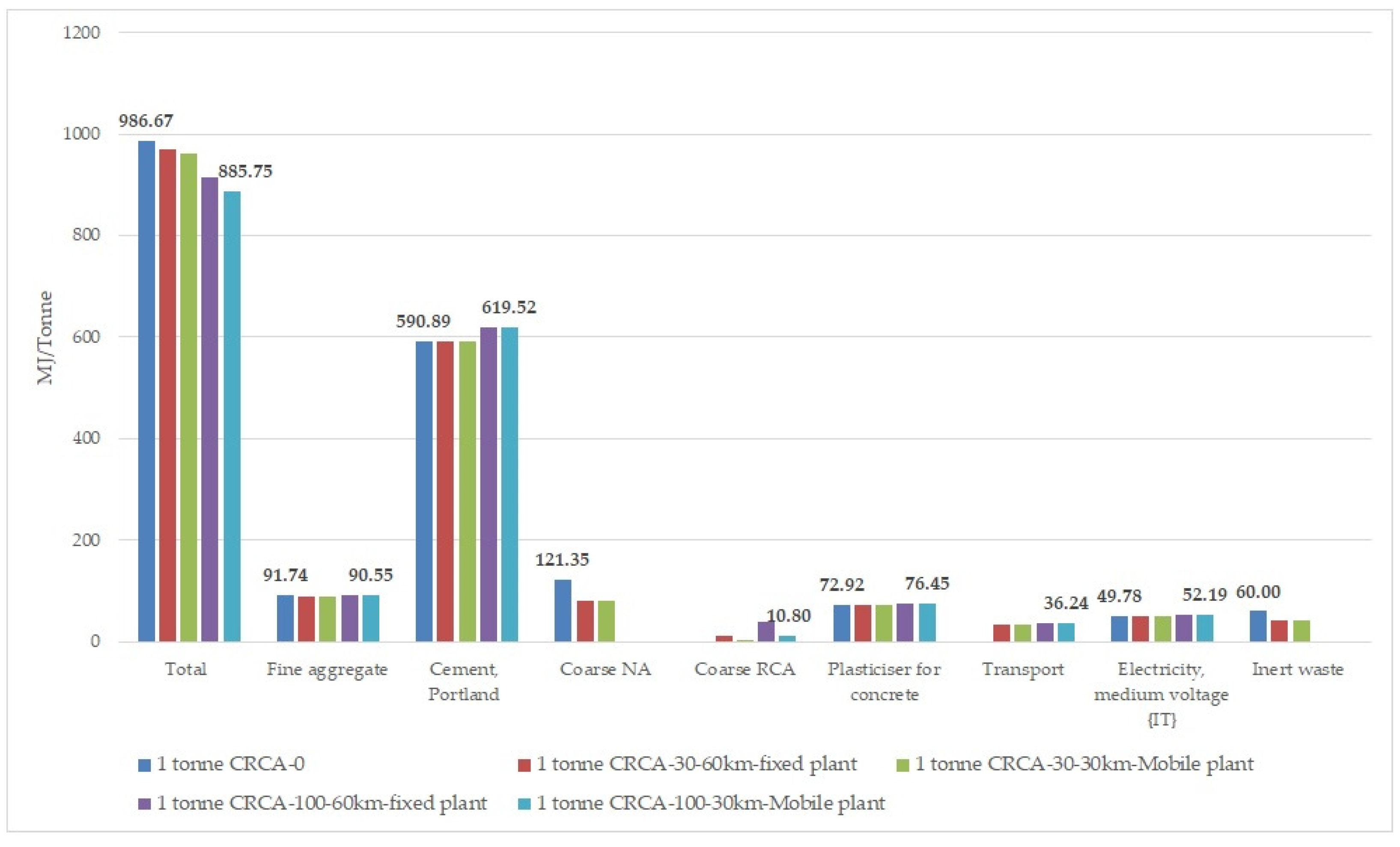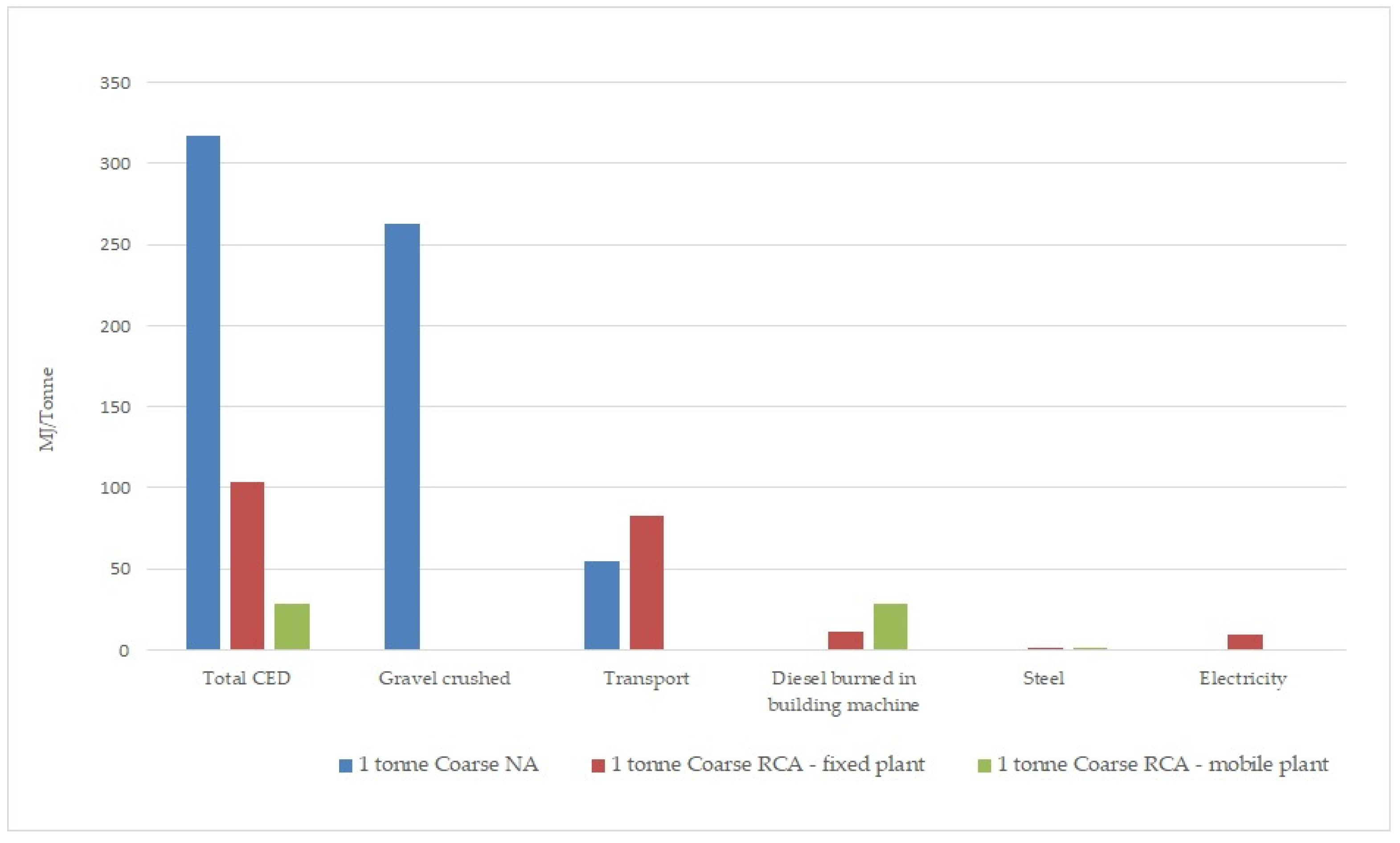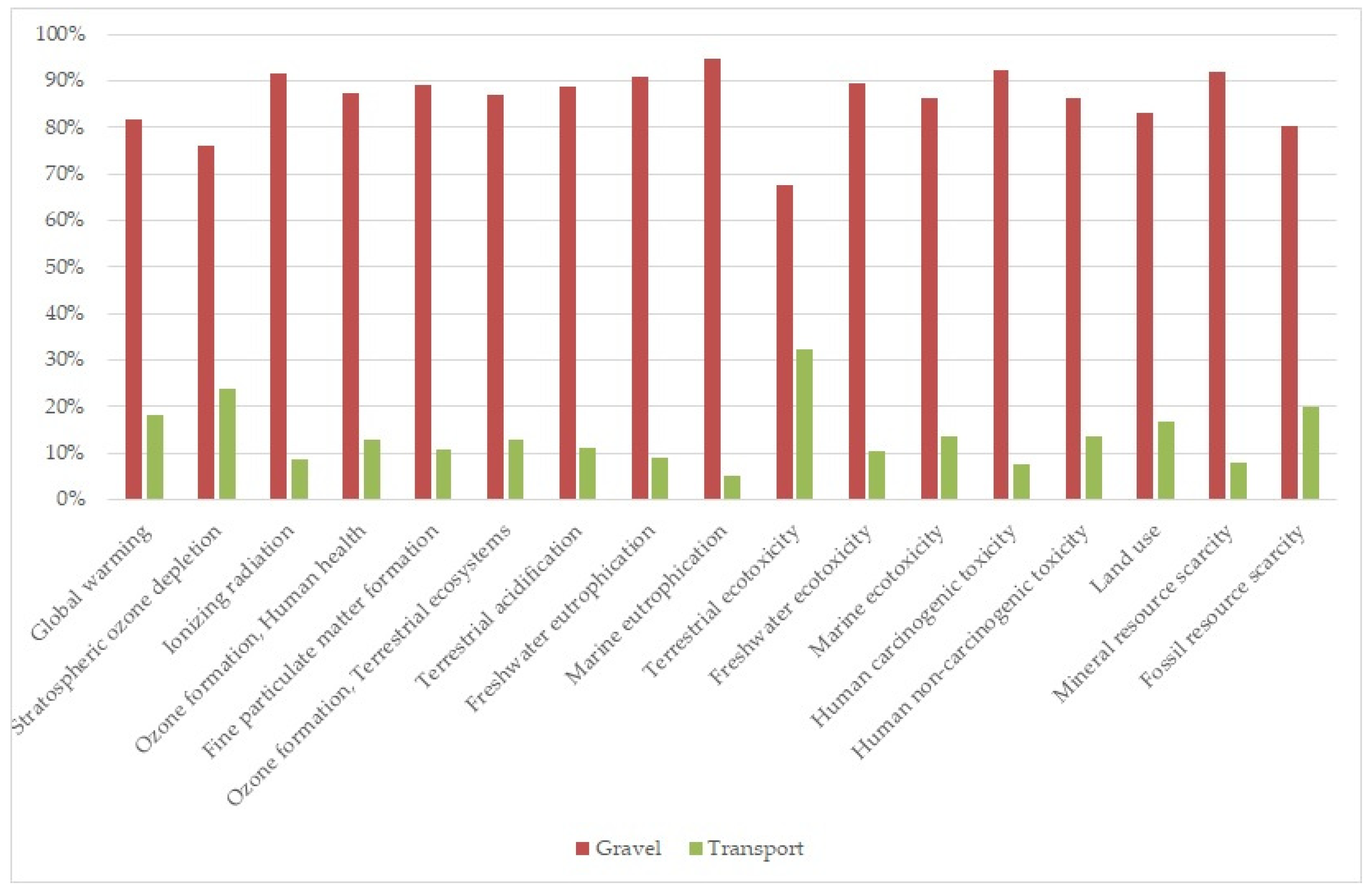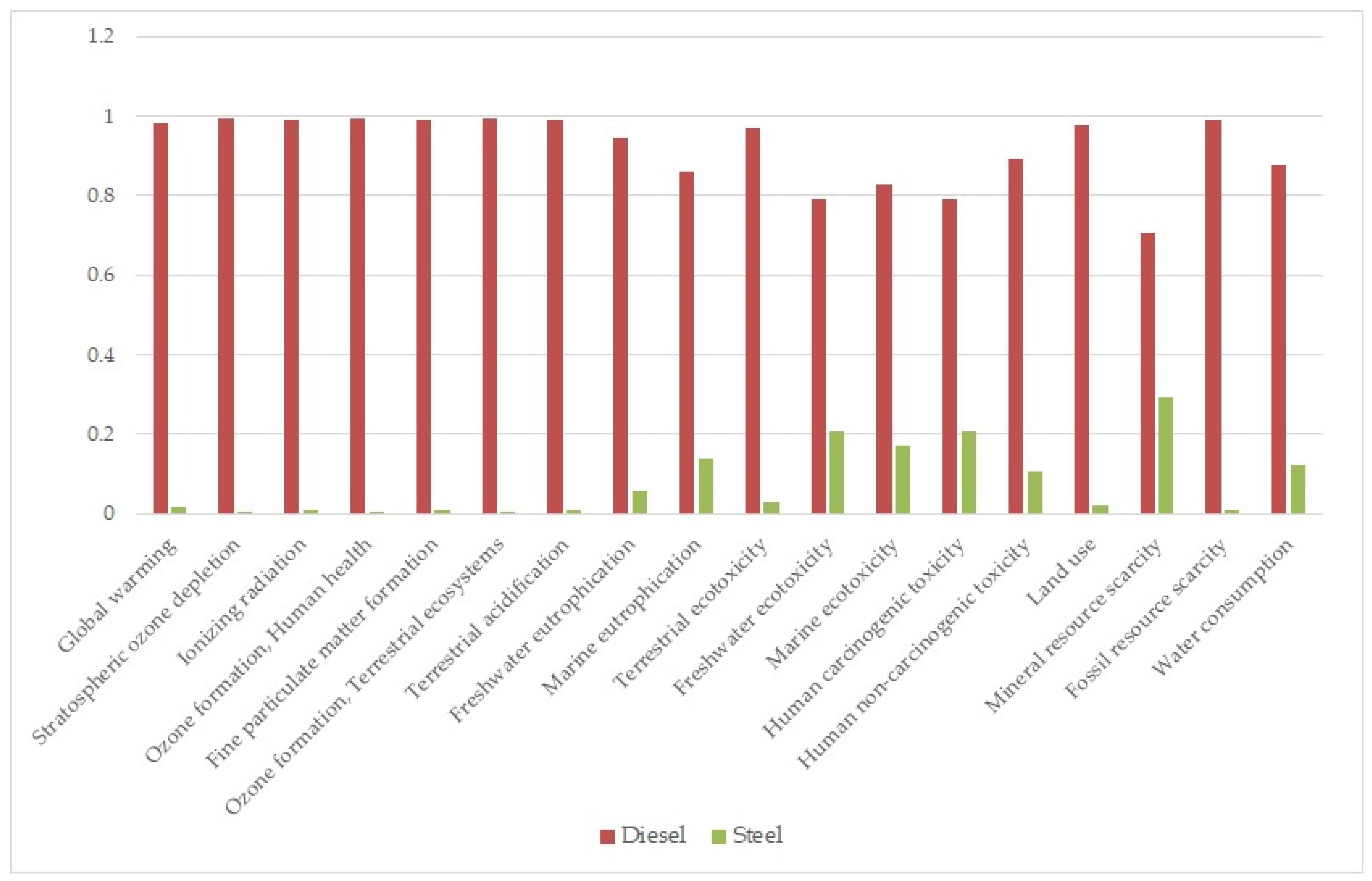Life Cycle Assessment of Concrete Production within a Circular Economy Perspective
Abstract
:1. Introduction
2. Materials and Methods
2.1. Analyzed Mixtures of This Study
2.2. Life Cycle Assessment
2.2.1. Goal and Scope Definition
- NA = 100%-CRCA = 0%. Fine aggregates (from rivers) and coarse NA (from quarries) are used. This corresponds to the mixture CRCA0;
- NA = 70%-CRCA = 30% recycled in a mobile plant. This mixture consists of coarse and fine NA and coarse RCA. This is the mixture CRCA 30-30 km mobile plant;
- NA = 70%-CRCA = 30% recycled in a fixed plant. This mixture consists of coarse and fine NA and coarse RCA. This is the mixture CRCA 30-60 km fixed plant;
- NA = 0%-CRCA = 100% recycled in a mobile plant, consists of only CRCA. This mixture is CRCA 100-30 km mobile plant;
- NA = 0%-CRCA = 100% recycled in a fixed plant, only CRCA are used. This mixture is CRCA100-60 km fixed plant.
- The C&D waste used as input only consists of the concrete fraction without other types of materials (e.g., mixed C&DW, metals, plastic, wood). This hypothesis assumes that, given the high quality of the input concrete, the mobile plant and the fixed plant provide the same quality of coarse RCA. All the mixtures are characterized by similar mechanical resistance and workability;
- The mobile treatment unit is in the same place of the demolished building/infrastructure project. This hypothesis is in line with the current practice, as the proximity with the demolition site is one of the main advantages of the mobile plants;
- The haulage from the fixed/mobile plant to the concrete manufacturing plant considers the same distance of 30 km;
- An average distance of 30 km is assumed from the demolition place to the fixed recycling unit;
2.2.2. Life Cycle Inventory
- Cement Portland (Europe without Switzerland): A quantity ranging from 143.94/tonne to 150.73 kg/tonne has been considered for all the five mixtures;
- Water, unspecified natural origin (IT): A quantity ranging from 89.90 kg/tonne to 101.85 kg/tonne has been assumed for the five mixtures;
- Additive (Superplasticizer for concrete): the quantity considered is 1.5% of the amount of cement;
- Electricity medium voltage (Italy): 1 m3 of concrete requires 14 kWh of electricity [19];
- Inert Waste (Europe without Switzerland) is the subprocess used for the disposal of C&DW in landfill.
2.2.3. Life Cycle Impact Assessment (LCIA)
3. Results
3.1. Life Cycle Energy Impacts (CED) of the Analyzed Five Mixtures for Concrete Production
3.2. Life Cycle Environmental Impacts of the Analyzed Five Mixtures for Concrete Production
4. Discussion
4.1. Environmental Performances of Concrete Mixtures Made of Coarse Natural and Recycled Concrete Aggregates
4.2. Impacts of Results for Future Policies
- 16,515,652 tonnes of natural aggregates;
- 43,241 tonnes of recycled aggregates;
- 21,344 tonnes of industrial aggregates.
4.3. Circular Economy, Life Cycle Assessment, Natural and Recycled Aggregates
5. Conclusions, Limitations, Policy Implications
Author Contributions
Funding
Institutional Review Board Statement
Informed Consent Statement
Data Availability Statement
Acknowledgments
Conflicts of Interest
Abbreviations
| CE | Circular Economy |
| C&D | Construction and Demolition |
| LCA | Life Cycle Assessment |
| NA | Natural Aggregate |
| FA | Fine Aggregate |
| RA | Recycled Aggregate |
| RCA | Recycled Concrete Aggregate |
| CRCA | Coarse Recycled Concrete Aggregate |
| RAC | Recycled Aggregate Concrete |
| RC | Recycled Concrete |
| CC | Conventional Concrete |
| CED | Cumulative Energy Demand (composed of non-renewable fossil, non-renewable nuclear, non-renewable biomass, Renewable biomass, Renewable, wind, solar, geothermal, Renewable water) |
| Functional Unit | FU |
| Life Cycle Inventory | LCI |
| Life Cycle Impact Assessment | LCIA |
| GWP | Global Warming Potential |
Appendix A
| UNEP Recommendations | Description |
|---|---|
| Recommendation 1 | Recognition of sand as a resource that provides critical ecosystems services and is an essential material for the construction of vital infrastructures in towsn and cities worldwide. |
| Recommendation 2 | Place-based perspectives inclusion for just sand transitions, ensuring the partecipation of all impacted people in decision-making, agenda-setting and action. |
| Recommendation 3 | Enable a paradigm shift to a regenerative and circular future. |
| Recommendation 4 | Adopt strategic and integrated policy and legal frameworks horizontally, vertically and Intersectional in agreement with local, national, and regional contexts |
| Recommendation 5 | Establish ownership and access to sand resources through mineral rights and consenting |
| Recommendation 6 | Map, monitor and report sand resources for transparent, science-based and data-driven decision-making |
| Recommendation 7 | Establish best practices and national standards, and a coherent international framework |
| Recommendation 8 | Promote resource efficiency and circularity by reducing the use of sand, replacing it with viable alternatives and recycling products made of sand when possible. |
| Recommendation 9 | Procurement of sand in an ethical, sustainable, and socially conscious way. |
| Recommendation 10 | Restore ecosystems and compensate for remaining losses by advancing knowledge, integrating the mitigation hierarchy, and promoting nature-based solutions |
References
- De Andrade Salgado, F.; De Andrade Silva, F. Recycled aggregates from construction and demolition waste towards an application on structural concrete: A review. J. Build. Eng. 2022, 52, 104452. [Google Scholar] [CrossRef]
- Benachio, G.L.F.; Do Carmo Duarte Freitas, M.; Tavares, S.F. Circular economy in the construction industry: A systematic literature review. J. Clean. Prod. 2020, 260, 121046. [Google Scholar] [CrossRef]
- Oluleye, B.I.; Chan, D.W.M.; Saka, A.B.; Olawumi, T.O. Circular economy research on building construction and demolition waste: A review of current trends and future research directions. J. Clean. Prod. 2022, 357, 131927. [Google Scholar] [CrossRef]
- Da Silva, S.R.; Andrade, J.J.d.O. A Review on the Effect of Mechanical Properties and Durability of Concrete with Construction and Demolition Waste (CDW) and Fly Ash in the Production of New Cement Concrete. Sustainability 2022, 14, 6740. [Google Scholar] [CrossRef]
- Silva, R.V.; De Brito, J.; Dhir, R.K. Availability and processing of recycled aggregates within the construction and demolition supply chain: A review. J. Clean. Prod. 2017, 143, 598–614. [Google Scholar] [CrossRef] [Green Version]
- Marinković, S.; Carević, V. Comparative studies of the life cycle analysis between conventional and recycled aggregate concrete. In New Trends in Eco-efficient and Recycled Concrete; Woodhead Publishing Series in Civil and Structural Engineering; de Brito, J., Agrela, F., Eds.; Woodhead Publishing: Cambridge, UK, 2019; pp. 257–291. [Google Scholar]
- Marinković, S.; Radonjanin, V.; Malesev, M.; Ignjatovic, I. Comparative environmental assessment of natural and recycled aggregate concrete. Waste Manag. 2010, 30, 2255–2264. [Google Scholar] [CrossRef] [PubMed]
- Ongpeng, J.M.C.; Ginga, C.P. Life Cycle Assessment and Carbon Footprint Analysis of Recycled Aggregates in the Construction of Earth-Retaining Walls during Reconstruction. In Advances of Footprint Family for Sustainable Energy and Industrial Systems. Green Energy and Technology; Ren, J., Ed.; Springer: Cham, Switzerland, 2022. [Google Scholar] [CrossRef]
- Hossain, M.U.; Ng, S.T.; Antwi-Afari, P.; Amor, B. Circular economy and the construction industry: Existing trends, challenges and prospective framework for sustainable construction. Renew. Sustain. Energy Rev. 2020, 130, 10994. [Google Scholar] [CrossRef]
- Tam, V.W.Y.; Soomro, M.; Evangelista, A.C.J. A review of recycled aggregate in concrete applications (2000–2017). Constr. Build. Mater. 2018, 172, 272–292. [Google Scholar] [CrossRef]
- Da Silva, S.R.; Cimadon, F.N.; Borges, P.M.; Schiavon, J.Z.; Possan, E.; de Oliveira Andrade, J.J. Relationship between the mechanical properties and carbonation of concretes with construction and demolition waste. Case Stud. Constr. Mater. 2022, 16, e00860. [Google Scholar] [CrossRef]
- Amaral, R.C.; Rohden, A.B.; Garcez, M.R.; Andrade, J.J.D.O. Reuse of wood ash from biomass combustion in non-structural concrete: Mechanical properties, durability, and eco-efficiency. J. Mater. Cycles Waste Manag. 2022, 24, 2439–2454. [Google Scholar] [CrossRef]
- Borges, P.M.; Schiavon, J.Z.; da Silva, S.R.; Rigo, E.; Junior, A.N.; Possan, E.; de Oliveira Andrade, J.J. Mortars with recycled aggregate of construction and demolition waste: Mechanical properties and carbon uptake. Constr. Build. Mater. 2023, 387, 131600. [Google Scholar] [CrossRef]
- Pacheco, J.; de Brito, J. Recycled Aggregates Produced from Construction and Demolition Waste for Structural Concrete: Constituents, Properties and Production. Materials 2021, 14, 5748. [Google Scholar] [CrossRef] [PubMed]
- Tošić, N.; Marinković, S.; Dašić, T.; Stanić, M. Multicriteria optimization of natural and recycled aggregate concrete for structural use. J. Clean. Prod. 2015, 87, 766–776. [Google Scholar] [CrossRef]
- Bayram, B.; Greiff, K. Life cycle assessment on construction and demolition waste recycling: A systematic review analyzing three important quality aspects. Int. J. Life Cycle Assess. 2023. [Google Scholar] [CrossRef]
- Xing, W.; Tam, V.W.; Le, K.N.; Hao, J.L.; Wang, J. Life cycle assessment of recycled aggregate concrete on its environmental impacts: A critical review. Constr. Build. Mater. 2022, 317, 125950. [Google Scholar] [CrossRef]
- Ghisellini, P.; Ncube, A.; D’Ambrosio, G.; Passaro, R.; Ulgiati, S. Potential Energy Savings from Circular Economy Scenarios Based on Construction and Agri-Food Waste in Italy. Energies 2021, 14, 8561. [Google Scholar] [CrossRef]
- Colangelo, F.; Petrillo, A.; Farina, I. Comparative environmental evaluation of recycled aggregates from construction and demolition wastes in Italy. Sci. Total Environ. 2021, 798, 149250. [Google Scholar] [CrossRef]
- Ding, T.; Xiao, J.; Tam, V.W.Y. A closed-loop life cycle assessment of recycled aggregate concrete utilization in China. Waste Manag. 2016, 56, 367–375. [Google Scholar] [CrossRef] [PubMed]
- Knoeri, C.; Sanyé-Mengual, E.; Althaus, H.-J. Comparative LCA of recycled and conventional concrete for structural applications. Int. J. Life Cycle Assess. 2013, 18, 909–918. [Google Scholar] [CrossRef] [Green Version]
- Estanqueiro, B.; Dinis Silvestre, J.; de Brito, J.; Duarte Pinheiro, M. Environmental life cycle assessment of coarse natural and recycled aggregates for concrete. Eur. J. Environ. Civ. Eng. 2018, 22, 429–449. [Google Scholar] [CrossRef]
- Frischknecht, R.; Wyss, F.; Büsser Knöpfel, S.; Lützkendorf, T.; Balouktsi, M. Cumulative energy demand in LCA: The energy harvested approach. Int. J. Life Cycle Assess. 2015, 20, 957–969. [Google Scholar] [CrossRef]
- Huijbregts, M.A.J.; Steinmann, Z.J.N.; Elshout, P.M.F.; Stam, G.; Verones, F.; Vieira, M.D.M.; Hollander, A.; Zijp, M.; Van Zelm, R. ReCiPe, 2016 v1.1: A Harmonized Life Cycle Impact Assessment Method at Midpoint and Endpoint Level Report I: Characterization. Int. J. Life Cycle Assess. 2017, 22, 138–147. [Google Scholar] [CrossRef]
- ISO 14044/2006. Available online: https://www.iso.org/standard/38498.html (accessed on 29 June 2023).
- Curren, M.A. Overview of Goal and Scope Definition in Life Cycle Assessment. In Goal and Scope Definition in Life Cycle Assessment; LCA Compendium—The Complete World of Life Cycle Assessment; Curran, M., Ed.; Springer: Dordrecht, The Netherlands, 2017. [Google Scholar] [CrossRef]
- Nieuwlaar, E. Life Cycle Assessment and Energy Systems. In Reference Module in Earth Systems and Environmental Sciences; Elsevier: Amsterdam, The Netherlands, 2013. [Google Scholar] [CrossRef]
- Iodice, S.; Garbarino, E.; Cerreta, M.; Tonini, D. Sustainability assessment of Construction and Demolition Waste management applied to an Italian case. Waste Manag. 2021, 128, 83–98. [Google Scholar] [CrossRef] [PubMed]
- Borghi, G.; Pantini, S.; Rigamonti, L. Life cycle assessment of non-hazardous Construction and Demolition Waste (CDW) management in Lombardy Region (Italy). J. Clean. Prod. 2018, 184, 815–825. [Google Scholar] [CrossRef]
- Blengini, G.A.; Garbarino, E. Resources and waste management in Turin (Italy): The role of recycled aggregates in the sustainable supply mix. J. Clean. Prod. 2010, 18, 1021–1030. [Google Scholar] [CrossRef]
- Ecoinvent 3.8 Database. Available online: https://ecoinvent.org/the-ecoinvent-database/data-releases/ecoinvent-3-8/ (accessed on 15 May 2023).
- Pacheco-Torgal, F. Introduction to advances in construction and demolition waste. In Advances in Construction and Demolition Waste Recycling: Management, Processing and Environmental Assessment; Pacheco-Torgal, F., Ding, Y., Colangelo, F.F., Rabin, T., Koutamanis, A., Eds.; Woodhead Publishing Series in Civil and Structural Engineering; Woodhead Publishing: Cambridge, UK, 2019. [Google Scholar]
- Federbeton Confindustria. Rapporto di Filiera 2021. Available online: https://www.federbeton.it/Pubblicazioni (accessed on 10 March 2023). (In Italian).
- Global Cement and Concrete Association. Cement and Concrete Around the World. Available online: https://gccassociation.org/concretefuture/cement-concrete-around-the-world/ (accessed on 10 March 2023).
- Federbeton Confindustria. Rapporto di Sostenibilità 2021. Available online: https://www.federbeton.it/Portals/0/pubdoc/pubblicazioni/Rapporti/Rapporto_di_Sostenibilit%C3%A0_Federbeton_2021.pdf?ver=2022-10-10-123207-383 (accessed on 10 March 2023). (In Italian).
- Legambiente. Rapporto Cave 2021. La Transizione Dell’economia Circolare nel Settore Delle Costruzioni. Available online: https://www.legambiente.it/wp-content/uploads/2021/07/Rapporto-Cave-2021.pdf (accessed on 10 March 2023).
- UNEP (United Nations Environment Programme). Sand, Rarer Than One Thinks. Available online: https://wedocs.unep.org/bitstream/handle/20.500.11822/8665/GEAS_Mar2014_Sand_Mining.pdf?sequence=3&isAllowed=y%20 (accessed on 8 March 2023).
- UNEP (United Nations Environment Programme). Sand and Sustainability: 10 Strategic Recommendations to Avert a Crisis. Available online: https://unepgrid.ch/storage/app/media/Publications/2022sandandsustainabilityreportfinal.pdf (accessed on 9 March 2023).
- John, E. The impacts of sand mining in Kallada river (Pathanapuram Taluk), Kerala. J. Basic Appl. Biol. 2009, 3, 108–113. [Google Scholar]
- Graedel, T.E. Material flow analysis from origin to evolution. Environ. Sci. Technol. 2019, 53, 12188–12196. [Google Scholar] [CrossRef]
- Brown, M.; Ulgiati, S. Emergy evaluation of biosphere and natural capital. Ambio 1999, 28, 428–493. [Google Scholar]
- Ellen MacArthur Foundation. Completing the Picture: How the Circular Economy Tackles Climate Change. Available online: https://circulareconomy.europa.eu/platform/sites/default/files/emf_completing_the_picture.pdf (accessed on 9 March 2023).
- Mercalli, L. Consumo di suolo. L’uomo contro il “suo” ambiente (In Italian). Il Fatto Quotidiano. 2023. [Google Scholar]
- Di Gennaro, A. Campania, stop al consumo di suolo (In Italian). La Repubblica, Napoli. 3 February 2023. [Google Scholar]
- Giorgi, S.; Lavagna, M.; Wang, K.; Osmani, M.; Liu, G. Drivers and barriers towards circular economy in the building sector: Stakeholder interviews and analysis of five European countries policies and practices. J. Clean. Prod. 2022, 336, 130395. [Google Scholar] [CrossRef]
- Pantini, S.; Rigamonti, L. Is selective demolition always a sustainable choice? Waste Manag. 2019, 103, 169–176. [Google Scholar] [CrossRef]
- Cristiano, S.; Ghisellini, P.; D’Ambrosio, G.; Xue, J.; Nesticò, A.; Gonella, F.; Ulgiati, S. Construction and demolition waste in the Metropolitan City of Naples, Italy: State of the art, circular design, and sustainable planning opportunities. J. Clean. Prod. 2021, 293, 125856. [Google Scholar] [CrossRef]
- Ghisellini, P.; Ji, X.; Liu, G.; Ulgiati, S. Evaluating the transition towards cleaner production in the construction and demolition sector of China: A review. J. Clean. Prod. 2018, 195, 418–434. [Google Scholar] [CrossRef]
- Coelho, A.; De Brito, J. Influence of construction and demolition waste management on the environmental impact of buildings. Waste Manag. 2012, 32, 532–541. [Google Scholar] [CrossRef] [PubMed]
- Directive 2008/98/EC of the European Parliament and of the Council of 19 November 2008 on Waste and Repealing Certain Directives. Available online: https://eur-lex.europa.eu/legal-content/EN/TXT/?uri=CELEX%3A32008L0098 (accessed on 16 July 2023).
- Harala, L.; Alkki, L.; Aarikka-Stenroos, L.; Al-Najjar, A.; Malmqvist, T. Industrial ecosystem renewal towards circularity to achieve the benefits of reuse—Learning from circular construction. J. Clean. Prod. 2023, 389, 135885. [Google Scholar] [CrossRef]






| Mixture | Coarse Natural Aggregates (kg/Tonne) | Coarse Recycled Concrete Aggregates (% of the Total Amount of the Mixture) | Coarse Recycled Concrete Aggregates (kg/Tonne) | Fine Aggregates (kg/Tonne) | Ordinary Portland Cement (kg/Tonne) | Water (kg/Tonne) | HRWR * (%OPC) | Total Mass (kg/Tonne) |
|---|---|---|---|---|---|---|---|---|
| CRCA0 | 383.03 | 0 | 0 | 380.85 | 143.93 | 89.89 | 1.5 | 997.72 |
| CRCA30-60 km (fixed plant) | 265.40 | 30% | 113.68 | 376.77 | 149.01 | 100.69 | 1.5 | 1005.57 |
| CRCA30-30 km (mobile plant) | 265.40 | 30% | 113.68 | 376.77 | 149.01 | 100.69 | 1.5 | 1005.57 |
| CRCA 100-60 km (fixed plant) | 0 | 100% | 377.52 | 375.45 | 150.72 | 101.85 | 1.5 | 1005.55 |
| CRCA100-30 km (mobile plant) | 0 | 100% | 377.52 | 375.45 | 150.72 | 101.85 | 1.5 | 1005.55 |
| Main Input and Their Subprocesses | FU | |
|---|---|---|
| 1. | Fine Aggregates. Ecoinvent 3.8:
| 1 tonne |
| 2. | Coarse Natural Aggregate.; Ecoinvent 3.8:
| 1 tonne |
| 3. | Coarse Recycled Concrete Aggregate (CRCA) (Fixed treatment plant). Ecoinvent 3.8:
| 1 tonne |
| 4. | Coarse Recycled Concrete Aggregate (CRCA) (Mobile treatment plant). Transport to the concrete facility: 30 km. Ecoinvent 3.8:
| 1 tonne |
| Input | Recycling Mobile Plants | Recycling Fixed Plants | Reference |
|---|---|---|---|
| Electricity | 1.13 kWh/tonne | Borghi et al. [29] | |
| 1.002 kWh/tonne | Blengini and Garbarino [30] | ||
| Diesel | 0.64 L/tonne | 0.25 L/tonne | Borghi et al. [29] |
| 0.688 L/tonne | 0.680 L/tonne | Blengini and Garbarino [30] | |
| 23.46 MJ/tonne | Estanquieiro et al. [22] | ||
| Water | 1.56 L/tonne | Borghi et al. [29] | |
| 6.7 kg/tonne | Blengini and Garbarino [30] | ||
| Steel | 0.02 kg/tonne | 0.02 kg/tonne | Borghi et al. [29] |
| 0.0105 kg/tonne | Blengini and Garbarino [30] |
| Mixtures for Concrete Production | Unit/Tonne | Total CED Impacts | Fine NA | Cement, Portland | Coarse NA | Coarse RCA | Plasticizer for Concrete | Transport | Electricity, Medium Voltage {IT} | Inert Waste Landfilling |
|---|---|---|---|---|---|---|---|---|---|---|
| CRCA-0 | MJ | 986.67 | 91.74 | 590.89 | 121.35 | 0 | 72.92 | - | 49.78 | 60.00 |
| CRCA-30-60 km-fixed plant | MJ | 970.09 | 87.68 | 590.89 | 81.21 | 11.32 | 72.92 | 34.57 | 49.78 | 41.73 |
| CRCA-30-30 km-mobile plant | MJ | 961.91 | 87.68 | 590.89 | 81.21 | 3.14 | 72.92 | 34.57 | 49.78 | 41.73 |
| CRCA-100-60 km-fixed plant | MJ | 913.93 | 90.55 | 619.52 | 0 | 38.97 | 76.45 | 36.24 | 52.19 | - |
| CRCA-100-30 km-mobile plant | MJ | 885.75 | 90.55 | 619.52 | 0 | 10.80 | 76.45 | 36.24 | 52.19 | - |
| Impact Category | Unit/Tonne | CRCA-0 | CRCA-30-30 km Mobile Plant | CRCA-30-60 km-Fixed Plant | CRCA-100-60 km-Fixed Plant | CRCA-100-30 km-Mobile Plant | CRCA-0/CRCA-100-30 km-Mobile Plant |
|---|---|---|---|---|---|---|---|
| Global warming potential | kg CO2 eq | 144.35 | 143.28 | 143.76 | 145.39 | 143.77 | −0.4% |
| Stratospheric ozone depletion | kg CFC11 eq | 0.00 | 0.00 | 0.00 | 0.00 | 0.00 | −11.0% |
| Ionizing radiation | kBq Co-60 eq | 9.56 | 9.18 | 9.22 | 8.59 | 8.43 | −11.8% |
| Ozone formation, Human health | kg NOx eq | 0.31 | 0.30 | 0.30 | 0.28 | 0.28 | −8.4% |
| Fine particulate matter formation | kg PM2.5 eq | 0.11 | 0.10 | 0.10 | 0.10 | 0.10 | −10.3% |
| Ozone formation, Terrestrial ecosystems | kg NOx eq | 0.31 | 0.30 | 0.30 | 0.29 | 0.29 | −8.4% |
| Terrestrial acidification | kg SO2 eq | 0.28 | 0.27 | 0.27 | 0.26 | 0.26 | −7.7% |
| Freshwater eutrophication | kg P eq | 0.02 | 0.02 | 0.02 | 0.02 | 0.02 | −11.6% |
| Marine eutrophication | kg N eq | 0.00 | 0.00 | 0.00 | 0.00 | 0.00 | −5.6% |
| Terrestrial ecotoxicity | kg 1,4-DCB | 339.34 | 343.72 | 354.12 | 323.63 | 287.83 | −15.2% |
| Freshwater ecotoxicity | kg 1,4-DCB | 4.50 | 3.63 | 3.64 | 1.69 | 1.64 | −63.4% |
| Marine ecotoxicity | kg 1,4-DCB | 45,630.02 | 35,044.85 | 35,168.17 | 11,032.96 | 10,608.42 | −76.8% |
| Human carcinogenic toxicity | kg 1,4-DCB | 254.58 | 233.36 | 234.82 | 190.61 | 185.57 | −27.1% |
| Human non-carcinogenic toxicity | kg 1,4-DCB | 40,174.34 | 30,706.73 | 30,806.21 | 9239.88 | 8897.41 | −77.9% |
| Land use | m2a crop eq | 4.12 | 3.93 | 3.96 | 3.74 | 3.64 | −11.6% |
| Mineral resource scarcity | kg Cu eq | 0.77 | 0.76 | 0.76 | 0.78 | 0.77 | 0.04% |
| Fossil resource scarcity | kg oil eq | 18.17 | 17.77 | 17.94 | 16.85 | 16.27 | −10.5% |
| Water consumption | m3 | 1.07 | 0.98 | 0.99 | 0.89 | 0.88 | −17.3% |
| Impact Category | Unit/Tonne | Coarse NA | Coarse RCA Fixed Plant | Coarse RCA Mobile Plant |
|---|---|---|---|---|
| Global warming potential | kg CO2 eq | 18.53 | 6.22 | 1.91 |
| Stratospheric ozone depletion | kg CFC11 eq | 0.00 | 0.00 | 0.00 |
| Ionizing radiation | kBq Co-60 eq | 3.54 | 0.60 | 0.16 |
| Ozone formation, Human health | kg NOx eq | 0.09 | 0.03 | 0.02 |
| Fine particulate matter formation | kg PM2.5 eq | 0.04 | 0.01 | 0.01 |
| Ozone formation, Terrestrial ecosystems | kg NOx eq | 0.09 | 0.03 | 0.02 |
| Terrestrial acidification | kg SO2 eq | 0.08 | 0.02 | 0.01 |
| Freshwater eutrophication | kg P eq | 0.01 | 0.00 | 0.00 |
| Marine eutrophication | kg N eq | 0.00 | 0.00 | 0.00 |
| Terrestrial ecotoxicity | kg 1,4-DCB | 198.11 | 97.33 | 2.51 |
| Freshwater ecotoxicity | kg 1,4-DCB | 0.72 | 0.13 | 0.01 |
| Marine ecotoxicity | kg 1,4-DCB | 5302.43 | 1198.85 | 74.33 |
| Human carcinogenic toxicity | kg 1,4-DCB | 136.98 | 19.98 | 6.65 |
| Human non-carcinogenic toxicity | kg 1,4-DCB | 4298.79 | 953.35 | 46.22 |
| Land use | m2a crop eq | 1.05 | 0.29 | 0.03 |
| Mineral resource scarcity | kg Cu eq | 0.08 | 0.01 | 0.00 |
| Fossil resource scarcity | kg oil eq | 5.90 | 2.15 | 0.62 |
| Water consumption | m3 | 0.42 | 0.02 | 0.00 |
Disclaimer/Publisher’s Note: The statements, opinions and data contained in all publications are solely those of the individual author(s) and contributor(s) and not of MDPI and/or the editor(s). MDPI and/or the editor(s) disclaim responsibility for any injury to people or property resulting from any ideas, methods, instructions or products referred to in the content. |
© 2023 by the authors. Licensee MDPI, Basel, Switzerland. This article is an open access article distributed under the terms and conditions of the Creative Commons Attribution (CC BY) license (https://creativecommons.org/licenses/by/4.0/).
Share and Cite
Cerchione, R.; Colangelo, F.; Farina, I.; Ghisellini, P.; Passaro, R.; Ulgiati, S. Life Cycle Assessment of Concrete Production within a Circular Economy Perspective. Sustainability 2023, 15, 11469. https://doi.org/10.3390/su151411469
Cerchione R, Colangelo F, Farina I, Ghisellini P, Passaro R, Ulgiati S. Life Cycle Assessment of Concrete Production within a Circular Economy Perspective. Sustainability. 2023; 15(14):11469. https://doi.org/10.3390/su151411469
Chicago/Turabian StyleCerchione, Roberto, Francesco Colangelo, Ilenia Farina, Patrizia Ghisellini, Renato Passaro, and Sergio Ulgiati. 2023. "Life Cycle Assessment of Concrete Production within a Circular Economy Perspective" Sustainability 15, no. 14: 11469. https://doi.org/10.3390/su151411469
APA StyleCerchione, R., Colangelo, F., Farina, I., Ghisellini, P., Passaro, R., & Ulgiati, S. (2023). Life Cycle Assessment of Concrete Production within a Circular Economy Perspective. Sustainability, 15(14), 11469. https://doi.org/10.3390/su151411469











